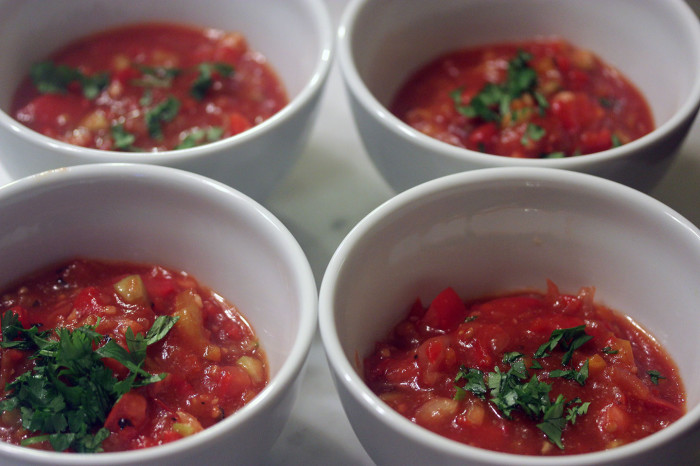I remember my first gazpacho recipe. It was a long time ago and I found myself, for the usual reasons, suddenly living alone with no one else around to cook for me. I had gone about a week at this new branch of life and it was rapidly dawning on me that I would not last a month on a diet of chicken wings and chocolate chip cookies.
By chance, there was a PBS station on and someone there had a big basket of veggies and a blender. I could almost taste the soup being made that day. And, ever since, gazpacho has been a staple on my table.
It’s a summer dish, that’s true, but it now happens to be summer. And there happen to be tomatoes at every farm stand — the much preferred location to acquire tomatoes. So, here is a basic recipe that you can begin your own gazpacho journey with.
Suzen and I will often supplement our gazpacho with additional ingredients: small cooked chunks of potato, corn kernels either roasted or just fresh off the cob. We almost always include herbs from our garden, snipping off a leaf or two here and there. If the chives needed some pruning, into the blender they go.
Gazpacho will never taste the same twice. It can’t. Even if you follow the same recipe to the letter, those core ingredient tomatoes are going to change depending on the weather, the farm they came from, or how long since they were harvested.
Enjoy the variety. This basic recipe should give you a running start for the whole summer.
What about the stale bread, that ingredient of classic peasant gazpacho? That was an extender used a long time ago and you’ll find recipes that call for it. Sometimes we do, but here we don’t. Adding the bread will shift the color from red to orange if you fully process the gazpacho. And it will thicken the soup. If you are a bread addict, of course you have the option of croutons or small toast pieces to garnish the soup, along with sour cream, herbs, diced onions, …
No two gazpachos are ever the same.
Basic Gazpacho
Yield: serves 4
Yield: serves 4
Ingredients:
• 6 ripe tomatoes, cut into chunks
• 1 large cucumber, peeled, halved and seeded, then cut into chunks
• 1 garlic clove, smashed
• 1 cup of tomato juice [your choice: plain or spicy]
• ⅓ cup good quality olive oil
• 3 tablespoons vinegar [your choice: balsamic, raspberry, sherry, …]
• Salt and freshly ground black pepper
• Herbs, such as cilantro, for garnish
Preparation:
In a blender, add the tomatoes, cucumber, garlic and tomato juice. Process briefly just to combine. You want it chunky, not smooth. Add the olive oil and vinegar. Pulse just to combine. Taste test and add salt, pepper and perhaps more vinegar. This is just a gross adjustment for taste. You’ll repeat this step again. So, if you are salt conscious, just wait.
Refrigerate until very well chilled: really cold and not just cool. Then taste test again and, if necessary, adjust the salt and pepper or even the vinegar.

